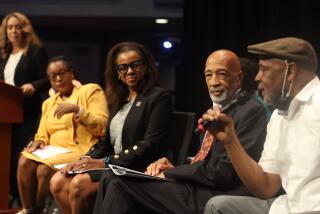Racism in the Workplace Puts Airline on Trial
- Share via
Just short of turning 58, Charles L. Walker is old enough to have painful memories of segregated bathrooms and whites-only water fountains he encountered as a youth in his native West Virginia.
But the View Park resident said the racism he encountered during the last few years as a mechanic for American Airlines at Los Angeles International Airport is “the worst thing that ever happened to me.”
When he entered a restroom at American’s maintenance facility at the airport one day in 1996, Walker was greeted by a handwritten sign proclaiming “All Blacks Must Die.”
Later in the same restroom, which is also used by supervisors, he found his name scrawled on the wall next to a Nazi swastika and discovered a cartoon depiction of himself with the words “N-----, N-----, N-----” written under his head. And he encountered a hangman’s noose--a symbol of lynchings--dangling in the main walkway leading to the nerve center of American’s servicing and repair facility.
In August 1997, after Walker filed a formal complaint with the state Department of Fair Employment and Housing, American launched a formal investigation. Richard J. Troy, the manager of American’s LAX maintenance facility, issued a memo declaring that “rope nooses” displayed in visible areas violated company rules. Supervisors held meetings with employees on the issue and American launched a “graffiti patrol.”
But company officials said they were unable to find out who was responsible for the graffiti or the nooses, and no one was disciplined.
Whether that response was forceful enough, and came early enough, is one of the key issues in a $10.5-million suit by Walker that is expected to come to trial in Los Angeles Superior Court this week.
The case could set a precedent in California for how proactive large companies must be in responding to racially discriminatory actions by their employees.
The trial of Walker’s case comes at a time when racial harassment claims are on the rise across the country. In 1998, 9,908 such claims were filed with the federal Equal Employment Opportunity Commission and similar state agencies, compared to 4,910 in 1991.
American spokesman Mark Slitt maintains that the company has a good race relations record, a formal anti-discrimination policy and an affirmative action program. He said the percentage of minority employees at the LAX maintenance facility was higher than in the company at large.
American does not challenge the allegations that there were racist graffiti and other symbols of hate in its workplace.
“Not everyone in the company is an angel,” Slitt said, referring to the Dallas-based airline’s 100,000 employees.
But the firm insists that it should not be held responsible for the actions of racist employees because it has a clear written policy against harassment and responded swiftly when informed of problems.
Walker, who was the only black crew chief at the maintenance facility, left American at the end of 1998. His attorneys, Ronald N. Wilson and Maurice Chenier, have raised several claims against the company, including charges that supervisors harassed Walker in various ways, including using a racial slur when addressing him. They argue that American should be held liable because the company failed for years to take sufficient action to curb racial harassment.
Numerous current and former employees have provided sworn statements describing other incidents involving hangman’s nooses and racist graffiti, sometimes staying up for months, at the maintenance facility going back as far as 1989.
In late July, Los Angeles County Superior Court Judge Dzintra Janavs rejected American’s bid to dismiss the case, saying, “I don’t think there is any question that there were awful racial things going on.
“I have a real problem with no one having done something, whatever they did, if anything, before ‘97,” the judge added.
Walker’s experiences are a stark reminder that graphic racist sentiments can still be found even in the workplaces of large, sophisticated corporations.
“Workers encounter things like this on a regrettably regular basis,” said Loyola Law School professor Catherine L. Fisk, an employment law specialist.
The case also illustrates the issues large corporations face in deciding how to deal with racial harassment allegations--a subject on which the law remains in flux.
Current standards have evolved primarily from cases involving sexual harassment.
Last year, the U.S. Supreme Court ruled that in sexual harassment cases, employers can be compelled to pay damages to workers who are harassed by a low-level supervisor, even if the company did not know about the harassment and the employee failed to complain immediately.
At the same time, the justices said employers may be able to escape liability if they have “effective” anti-harassment policies. A company’s defense is stronger, the court said, in cases in which an employee fails to use available means to inform management of his or her concerns.
In the last year, five lower federal courts have ruled that the same new principles apply in racial harassment cases. But that issue has not been considered by the U.S. Supreme Court. Nor has a California state court ruled yet on how the standards from the 1998 Supreme Court cases will impact cases brought under California fair employment laws, which are somewhat more protective of employees than federal statutes.
It is not easy for a plaintiff to win a racial harassment case. Many suits are thrown out before they get to a jury.
In one recent racial harassment decision, a federal appeals court said a company is not obliged to discharge “all Archie Bunkers in its employ.” Courts have, however, at times held firms accountable for the racist utterances and actions of their employees.
In a 1993 Mississippi case, a federal appeals court stressed that “the term ‘nigger’ is universally recognized opprobrium, stigmatizing African Americans because of their race.” Another federal appeals court, in 1989, said a noose hanging over a plaintiff’s workstation was good evidence of racial discrimination.
In the current Los Angeles case, American’s representatives argue that Walker, who joined the company in 1989 after working for several other large corporations and three years as a Los Angeles County deputy sheriff, should have informed them much earlier of the problems he was encountering, either in writing, via a company hotline or through his union. When the company was informed, officials acted promptly and responsibly, the nooses disappeared and the graffiti abated, American’s lawyer, Garry G. Mathiason, said.
Walker’s attorneys say the company did not do nearly enough. The problems were so blatant that the company had an obligation to take notice of them and act even without a formal complaint from an employee, they argue.
They have submitted sworn declarations from current and former employees stating that the racial graffiti--in places where it would have been clearly visible to American supervisors--often stayed up for weeks, sometimes even months. And in one court declaration, union steward Ronald V. Bolton noted that one hangman’s noose he saw near the production control office, which is frequented by supervisors, was hung from a bar 14 feet high, requiring a ladder to put it up. “Someone should have seen it being hung,” he said.
Legal experts say the fact that American was unable to find and punish a culprit is the sort of circumstance that can be very damaging to a defendant in a case like this. Courts in some cases have ruled that a company’s failure to punish someone can be evidence suggesting a lack of concern.
Another potential problem for the company is pretrial testimony that raises questions about how seriously aircraft maintenance manager Troy took the situation.
A company human resources official stated that Troy did not issue his memo against nooses until she told him to. And in his own deposition, Troy said displaying nooses could be offensive to certain employees, but that he did not think it was a form of harassment.
Asked if he thought that “the prominent display of graffiti or Nazi swastikas or hangman’s nooses” was “no big deal unless someone’s name, specific employee’s name, is attached to it,” Troy responded: “Yes.”
After that exchange, American’s lawyer asked for a recess. Following a 23-minute break, Troy returned, said he had been “very tired” and that he did consider such displays “a big deal.”
Pressed by Walker’s lawyer, Wilson, about when he had decided that, Troy answered: “When I went out for break.”
Because Troy was a supervisor, if a jury concludes that he failed to take the situation seriously, they could find American liable.
That sort of situation can be a dangerous one for large companies, said Marc Bendick, a Washington labor consultant who has testified for both employees and management in discrimination cases.
While stressing that he was not passing judgment on American’s conduct in this particular case, Bendick said “there often is a big difference between companywide policies and what happens at any individual location.”
“Even companies with extraordinary centralized systems to root out discrimination have problems,” he added. “The real question is not whether a company has an instance of discrimination but how do they treat it.”
More to Read
Sign up for Essential California
The most important California stories and recommendations in your inbox every morning.
You may occasionally receive promotional content from the Los Angeles Times.










